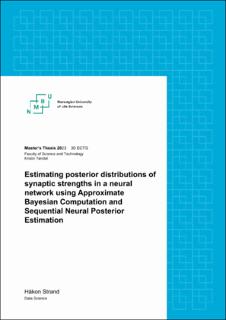Estimating posterior distributions of synaptic strengths in a neural network using Approximate Bayesian Computation and Sequential Neural Posterior Estimation
Master thesis
Permanent lenke
https://hdl.handle.net/11250/3077302Utgivelsesdato
2023Metadata
Vis full innførselSamlinger
- Master's theses (RealTek) [1722]
Sammendrag
In computational neuroscience, it is common to represent natural phenomena through mathematical models in the form of coupled differential equations. These models allow us to study neural networks in the brain by simulating and measuring neural activity, specifically spiking activity. This thesis examines a two-population neural network, consisting of one inhibitory and one excitatory population, to estimate the posterior distributions of four synaptic strength parameters. By varying these parameters in our simulations, we can analyze differences in spiking activity.
From the spiking data, represented by histograms, we computed four summary statistics per population (eight in total): mean firing rate, Fano factor, mean interspike interval and coefficient of variation. We then construct three likelihood-free methods in order to create posterior distributions of the synaptic strength parameters based on either the summary statistics or the raw output data. The posteriors are constructed using Approximate Bayesian Computation (ABC) and Sequential Neural Posterior Estimation (SNPE) methods. One rejection-based ABC method, with included linear regression adjustment, is constructed, as well as two SNPE methods: one using the summary statistics and the other using an embedding network (consisting of a convolutional neural network) to extract it's own metrics based on the raw output data.
Furthermore, we aim to evaluate the findings to best replicate the values of an observation. The observation is randomly selected from the simulated data, and then simulated an additional $100$ times with fixed parameter values to account for the stochastic properties of the network model. The mean of these additional simulations served as the observed summary statistics values, and the sample closest to this mean was selected as the raw output observation.
To evaluate the posteriors, we examine the extent to which the methods are capable of restricting the synaptic strength parameters, comparing this with the observation's output in terms of both summary statistics and raw output data. The SNPE method using an embedding network is the least capable of restricting the parameter domain and replicating the observation results. The linear regression adjusted ABC method shows some improvement over this, while the SNPE method without an embedding network appears to be the most successful in both restricting the parameter domain and replicating the observation output.
